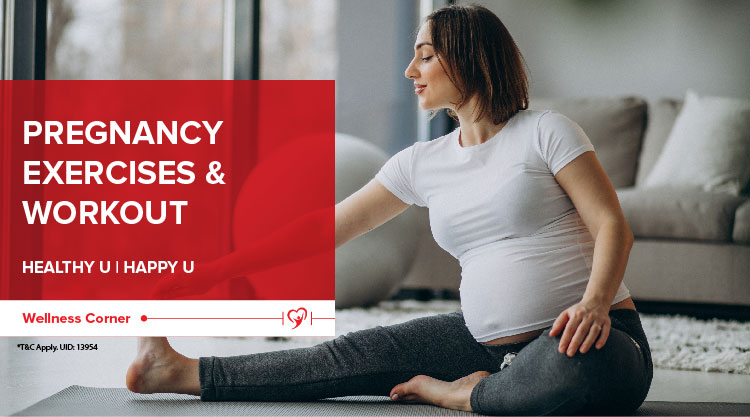

Pregnancy-Safe Workouts at Home
- Overview
- Is it safe?
- Exercises in the 1st Trimester
- Exercises in the 2nd Trimester
- Exercises in the 3rd Trimester
- What Exercises are Safe
- Exercises to Avoid
- Dos and Don'ts
- Who should Not Exercise
- Which month is safe to start
- When to Stop
- Exercising after Delivery
- Conclusion
- FAQs
Pregnancy Exercises
While everyone should regularly exercise to stay fit, it becomes even more important when you are expecting. Just like you take good care of your diet, your health and wellbeing require daily workout sessions too.
Exercising during pregnancy not only improves posture and stamina but also prevents backaches and reduces fatigue. However, not all pregnancy exercise tips might make sense to you. So, it’s important to rely on expert advice because each pregnancy is different from another in terms of the health needs of the baby and the mother.
But here are a few basic things to know.
Is It Safe to Exercise During Pregnancy?
Pregnancy exercises are safe if you are healthy with no pregnancy-related complications and as long as you feel comfortable. They are safe and healthy for both the mother and baby. Regular pregnancy exercises have many benefits, such as:
- Improves your overall fitness, and boosts your mood and energy levels
- Reduces back pains and fatigue, swelling, bloating and eases constipation
- Helps you sleep better
- Helps you gain the right amount of weight during pregnancy
- Helps reduce the risk of pregnancy complications like gestational diabetes and preeclampsia
- Makes labour easy by making it short and less complicated
- Strengthens the pelvic floor (like Kegel exercises)
- Helps reduce your risk of having a C-section
- Helps you lose weight after childbirth
- Keeps you active
However, before you prepare a pregnancy exercises chart, it’s better to discuss with your gynaecologist if exercising is safe for you.
Exercises in the First Trimester
- Walking
- Swimming
- Jogging
- Stationary cycling
- Pelvic curls
- Pelvic brace
- Squats
- Kneeling push-ups
- Bicep curls
Exercises in the Second Trimester
- Walking
- Swimming
- Jogging
- Stationary cycling
- Incline push-ups
- Side-lying leg lifts
- Mermaid stretch
- Hip flexor and quadriceps stretch
Exercises in the Third Trimester
- Low-weight exercises like bicep curls with light weights, push-ups against a wall, modified planks, etc.
- Walking
- Swimming
- Jogging
- Stationary cycling
- Pilates
- Pelvic floor exercises
- Prenatal yoga
What Exercises are Safe During Pregnancy?
Pregnancy exercises that are generally safe are:
1. Walking
- 30 minutes of walking, 5 days every week should be the goal.
- Ensure a speed that helps you keep up a conversation comfortably.
- Stop immediately if you find it difficult to breathe or experience dizziness.
- Carry water and sip on it now and then.
- Wear proper shoes, so you don’t slip or stumble.
2. Cycling, Preferably a Stationary Cycle
- Always focus on safety and comfort.
- Stay hydrated.
- Stop immediately if you feel dizzy, nauseous etc.
- Wear clothes that breathe.
- Adjust handlebars and saddle as your pregnancy progresses, for better stability.
3. Swimming and Aqua Aerobics
- Wear a swimsuit that fits well.
- Make sure you have company while swimming.
- Use a good sunscreen, preferably one that is broad spectrum.
- Breaststroke is ideal in advanced pregnancy, as it will boost the muscular strength in your chest and back.
- Some of the safest aqua aerobics moves to try are – flutter kick, squat, back leg curl, side leg lift and knee-up.
4. Low-Impact Aerobics
- Some of the best moves during pregnancy are – leg lifts, donkey kicks, standing cranes, marching arm stretches, stationary bikes, and pile squats.
- Warm up before you start and cool down once you are done.
- Drink adequate water.
- Avoid working out when it’s too hot.
- Choose good shoes and clothes that offer support.
5. Yoga, Pilates, and Breathing Exercises During Pregnancy
- The best yoga poses to try during pregnancy include the cat/cow pose, goddess pose, balancing table pose, and downward facing dog, to name a few.
- If you are interested in Pilates, seated curl and press, inner and outer thigh moves while lying on the side, and kneeling plank are ideal during pregnancy. The best moves are spiders, marbles, bend and extend and zippers.
- The most effective breathing exercises during pregnancy include – breathing from the stomach, and chest, shallow breathing and alternating deep and shallow breathing.
6. Kegel Exercises for Pregnancy
- Start pelvic floor exercises like Kegel only after your bladder is empty.
- Identify and focus on the muscles you use to stop urine flow.
- Once you pull up the muscles of the pelvic floor, squeeze them and count to 6 seconds. Then relax for 6 seconds. Repeat.
- You can do this 10 to 15 times every time you practise Kegel. Try and do it 3 times every day.
What Exercises to Avoid During Pregnancy?
The exercises to avoid during pregnancy are:
- Holding your breath during any activity
- Activities which have jerky, bouncing movements such as skiing, skating and horseback riding where there’s a risk of falling
- Avoid contact sports such as kickboxing, softball, basketball, football, and volleyball where there’s a risk of getting hit
- Activities in which there is extensive hopping, jumping, bouncing or skipping
- Avoid lying on your back for long, especially after your third month of pregnancy like in sit-ups
- Avoid exercising in hot, humid weather
- Scuba diving or skydiving
- Avoid exercising at high altitudes as it can lower the amount of oxygen reaching your baby
- Any activity that raises your body temperature too much
Dos and Don’ts of Exercising During Pregnancy
Now that you know what exercises are safe and what to avoid, it’s important to also know the dos and don’ts of exercising for a safe and healthy pregnancy.
Dos of Exercising
- If you were not physically active before getting pregnant, then start exercising gradually. Don’t aim at the recommended 30 minutes a day from day one. Start with 10-15 minutes and gradually increase the duration.
- Wear comfortable clothes, preferably loose fitting, and shoes to help you exercise efficiently and safely.
- Stay hydrated by drinking lots of water before, during, and after your workout.
- Go for less or average-intensity exercises, such as walking, yoga, gentle aerobics, gardening, swimming, etc.
- Make sure you warm up before and cool down after a workout. This will help relax the muscles and bring the body back to normal.
- Breathe properly while exercising.
- Listen to your body if it tells you to stop exercising, take a break, or slow down.
Don’ts of Exercising
- Avoid exercising in hot and humid conditions, as it can be risky. If it’s too hot outside, you can skip a day or do it in an air-conditioned room.
- Avoid workouts which involve twisting, rotating, or moving the abdomen or lifting heavy objects.
- Do not force yourself to exercise if you are feeling sick.
- Avoid sports activities like basketball, skiing, or horse riding where there’s a risk of falling.
- Avoid strenuous exercises.
- Avoid standing still or lying flat on your back for a long time, as it can affect your blood pressure.
- If you feel any discomfort, such as headache, dizziness, chest pain, difficulty breathing, painful contractions, or vaginal bleeding, stop exercising immediately.
- Last but not least, do not overdo it.
Who Should Not Exercise?
Anyone with the following medical conditions should not exercise while pregnant:
- Hypertension, asthma, heart disease and uncontrolled diabetes
- Vaginal bleeding or spotting
- Weak cervix
- Placenta previa or low placenta
- History of miscarriage or preterm delivery
- Premature labour during the present pregnancy
Which Month is Safe to Start Exercising?
You can start pregnancy exercises at home anytime during your pregnancy. If you have never exercised before, you can start after consulting your doctor to ensure a healthy pregnancy. You don’t need to hit the gym or take exercise classes. Just being active and making small changes in your daily routine can help. Just avoid stressing yourself.
When Should You Stop Exercising?
If you experience any of these signs and symptoms, stop exercising immediately and see your doctor:
- Feeling dizzy, nauseated or light-headed
- Chest pain, irregular or rapid heartbeat
- Shortness of breath
- Bleeding or amniotic fluid leakage from the vagina
- Abdominal or pelvic pain
- Swelling of the face, hands or feet
- Regular, painful contractions
- Persistent headache
- Muscle weakness, trouble walking, pain or swelling in the lower legs
- Change in the baby’s movements
- Excessive tiredness
How Soon Can You Start Exercising After Delivery?
This depends on how active you were during the pregnancy and what kind of delivery you had.
- If you were regularly exercising throughout your pregnancy and had a normal/vaginal delivery with no complications, you can safely start your workouts a few days after delivery or when your body is ready for it. Start with light exercises such as walking and stretching.
- If you had a C-section or any complications, you may need to wait for a few weeks.
- Whatever the case, start the exercises gradually and slowly, do not overdo them.
- Follow your doctor’s advice as to how soon you can resume your exercise regime. If you feel any discomfort, stop the activity and talk to your doctor.
Finally – To Exercise or Not?
Motherhood is a wonderful feeling. But pregnancy makes your body undergo a ton of changes. Hence, staying active and healthy should be your top priority. While regular exercises during pregnancy are beneficial for both the mother and baby, Kegel exercises during pregnancy prepare you for labour and childbirth.
However, as the pregnancy progresses, make sure to talk to your doctor before making any changes because pregnancy exercises in the second trimester and pregnancy exercises in the third trimester may not be the same. Depending on your health condition, the doctor can recommend safe exercises during pregnancy.
FAQs
1. I am pregnant. Is it safe to exercise?
Yes, it is safe to exercise if you are healthy with no pregnancy-related complications or other health conditions. In fact, exercising during pregnancy has many benefits, like keeping you active, improving your overall fitness, reducing the risk of C-section, etc. However, it’s better to take your doctor’s advice before starting workouts.
2. How much should I exercise during pregnancy?
Going for low or average-intensity exercises for at least 30 minutes a day, 5 days a week, is recommended. If you are new to exercise, you can start with 10-15 minutes and gradually increase the time. If you have been exercising regularly before pregnancy, you can continue with the same workouts after consulting your doctor. But remember to stop exercising when you feel sick or experience any discomfort.
3. Can I exercise soon after delivery?
This depends on the kind of delivery that you had. If it is a normal delivery with no complications, it is safe to start your workouts a few days after delivery or when your body is ready for it. If you had a C-section or any complications, you may need to wait for a few weeks to months or after your doctor gives you permission to resume your workout.
4. Can I continue the same exercises throughout my pregnancy?
No, because some pregnancy exercises may not be safe to do during all three trimesters. What is safe in the first trimester may not be recommended during the final trimester when your body prepares for childbirth. Your gynaecologist can recommend exercises which are safe for you depending on your health condition.
Source: webmd, marchofdimes, nhs.uk
Get a right Health Insurance today & protect your savings from unexpected medical expenses.
A healthy pregnancy ensures a healthy baby and a happy mommy. While you take every care to ensure your baby stays healthy, make sure you check out our health insurance plans that promise benefits and advantages for you and your little one.
Disclaimer: This blog provides general information and discussions about health and related subjects. The information and other content provided in this blog, website or in any linked materials are not intended and should not be considered, or used as a substitute for, medical advice, diagnosis or treatment. Kindly contact your Doctor before starting a new medicine or health regime.

/pregnancy-diet_s.jpg?sfvrsn=7a5ce0e5_2)
/pregnancy-care_s.jpg?sfvrsn=bc1596d4_2)
/postpartum-care_s.jpg?sfvrsn=c5fa68b_2)












 Health Insurance
Health Insurance  Travel Insurance
Travel Insurance  Car Insurance
Car Insurance  Cyber Insurance
Cyber Insurance  Critical Illness Insurance
Critical Illness Insurance
 Pet Insurance
Pet Insurance
 Bike/Two Wheeler Insurance
Bike/Two Wheeler Insurance  Home Insurance
Home Insurance  Third Party Vehicle Ins.
Third Party Vehicle Ins.  Tractor Insurance
Tractor Insurance  Goods Carrying Vehicle Ins.
Goods Carrying Vehicle Ins.  Passenger Carrying Vehicle Ins.
Passenger Carrying Vehicle Ins.  Compulsory Personal Accident Insurance
Compulsory Personal Accident Insurance  Travel Insurance
Travel Insurance  Rural
Rural 










